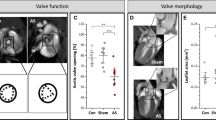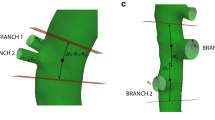Abstract
Transverse aortic constriction (TAC) is used as a model of left ventricular hypertrophy and failure; however, there is extensive variability in the hypertrophic response. In 43 mice that underwent TAC with a 7–0 polypropylene suture, 13 were identified by echocardiography with initial LV hypertrophy that halted or regressed over time. Post–mortem examination on 7 of these mice found the constricting band to be intact, but partially internalized into the aortic lumen, allowing blood flow around the stenosis. To confirm this prospectively in vivo we then followed 12 mice after TAC for 6 weeks, using a new high resolution 3D–MRI method to measure minimal aortic arch cross–sectional area (CSA). Three of the 12 mice developed a significantly increased aortic CSA (0.31 ± 0.15 on day 2 vs. 1.11 ± 0.29 mm2 on day 42; P < 0.05), which was independently confirmed by dissection. These mice had internalized part of the band within the aortic lumen and, by week 6, showed significantly less LV hypertrophy and better systolic function. Nine of the 12 mice showed no change in aortic CSA. Band internalization could be prevented when two banding sutures were placed side–by–side (n = 10). This is the first observation that a significant subset of animals following TAC bypass the stenosis resulting in partial regression of hypertrophy.
Similar content being viewed by others
References
Cassidy PJ, Schneider JE, Grieve SM, Lygate C, Neubauer S, Clarke K (2004) Assessment of motion gating strategies for mouse magnetic resonance at high magnetic fields. J Magn Reson Imaging 19:229–237
Ichinose F, Bloch KD, Wu JC, Hataishi R, Aretz HT, Picard MH, Scherrer Crosbie M (2004) Pressure overload-induced LV hypertrophy and dysfunction in mice are exacerbated by congenital NOS3 deficiency. Am J Physiol 286:H1070–H1075
Kiriazis H, Sato Y, Kadambi VJ, Schmidt AG, Gerst MJ, Hoit BD, Kranias EG (2002) Hypertrophy and functional alterations in hyperdynamic phospholamban-knockout mouse hearts under chronic aortic stenosis. Cardiov Res 53:372–381
Liao Y, Ishikura F, Beppu S, Asakura M, Takashima S, Asanuma H, Sanada S, Kim J, Ogita H, Kuzuya T, Node K, Kitakaze M, Hori M (2002) Echocardiographic assessment of LV hypertrophy and function in aortic-banded mice: necropsy validation. Am J Physiol 282:H1703–1708
Rockman HA, Ross RS, Harris AN, Knowlton KU, Steinhelper ME, Field LJ, Ross J Jr, Chien KR (1991) Segregation of atrial-speci .c and inducible expression of an atrial natriuretic factor transgene in an in vivo murine model of cardiac hypertrophy. Proc Natl Acad Sci USA 88:8277–8281
Schmitt JP, Semsarian C, Arad M, Gannon J, Ahmad F, Duffy C, Lee RT, Seidman CE, Seidman JG (2003) Consequences of pressure overload on sarcomere protein mutation- induced hypertrophic cardiomyopathy. Circulation 108:1133–1138
Schneider JE, Bamforth SD, Grieve SM, Clarke K, Bhattacharya S, Neubauer S (2003) High-resolution, high-throughput, magnetic resonance imaging of mouse embryonic anatomy using a fast gradientecho sequence. Magma 16:43–51
Schneider JE, Cassidy PJ, Lygate C, Tyler DJ, Wiesmann F, Grieve SM, Hulbert K, Clarke K, Neubauer S (2003) Fast, highresolution in vivo cine magnetic resonance imaging in normal and failing mouse hearts on a vertical 11.7 T system. J Magn Reson Imaging 18:691–701
Author information
Authors and Affiliations
Corresponding author
Additional information
Drs. Lygate and Schneider contributed equally to this work
Rights and permissions
About this article
Cite this article
Lygate, C.A., Schneider, J.E., Hulbert, K. et al. Serial high resolution 3D–MRI after aortic banding in mice: band internalization is a source of variability in the hypertrophic response. Basic Res Cardiol 101, 8–16 (2006). https://doi.org/10.1007/s00395-005-0546-3
Received:
Revised:
Accepted:
Published:
Issue Date:
DOI: https://doi.org/10.1007/s00395-005-0546-3




